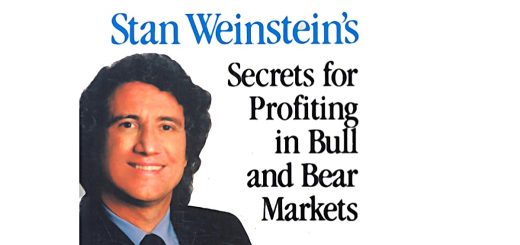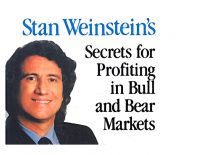Stan Weinstein’s Stage System 4 – Long-term Indicators

Today’s post is our fourth and final visit to the book “Secrets for Profiting in Bull and Bear Markets.” Today we’ll be looking at long-term market indicators.
Contents
The Professional Tape Reader
At the time he wrote the book, Stan was publishing a newsletter called the Professional Tape Reader.
- He starts Chapter 8 by recalling how he timed the bull market of 1982 and the crash of 1987.
- Both were tipped in the newsletter.
He was tracking 100 technical indicators and reporting on the 50 best ones in the newsletter.
- But for the book, he has selected a shortlist of eight.
Stage analysis of market averages
This is an obvious one.
- Just as with the stage analysis of a single stock, you track the average (index) and compare it to its 30-week moving average, to work out what Stage it’s in.
Buy on the transition from Stage 1 to Stage 2, and sell in Stage 3.
Advance-Decline line
This is a popular indicator in the US which compares the number of stocks that went up on the day to the number of stocks that went down.
- The net score from each day is added to the running total from the previous day.
It’s not such a popular indicator in the UK and I’m not sure where to source it for free on the FTSE All-Share.
- If anyone knows where to get it, please tell us in the comments.
Stan looks for divergence between the AD line and the index – often the AD line will act as an early warning, declining before the index.
- Note that at bottoms, the AD line will continue to fall as the index starts to turn back up – in this case the divergence is a positive sign.
Momentum index
Stan also uses a 200-day moving average of the daily AD figures, which he calls his Momentum Index (MI).
- The most important MI signal is crossing the zero line – a move up is bullish, and a move down is bearish.
- The longer the line has been on the other side of zero, the stronger is the crossing signal.
- The further away the indicator has been from zero before crossing, the stronger is the signal.
The MI should peak before the market index does.
- The MI indicator can be late on bottoms, so it is not so useful here.
Highs and lows
Stan also tracks the numbers of new highs and new lows (common stocks only, not preferreds).
- He uses weekly highs and lows rather than daily.
This is a very early signal, at both bottoms and tops.
- Divergence from the index is the signal.
International markets
Stan also tracks the indices for key international markets.
- He finds that the strongest moves in the US markets occur when they are aligned with international markets.
General Motors
One of the oddest indicators Stan uses is the General Motors stock price.
- Back in the 1950s a member of the US cabinet said “What’s good for GM is good for America”, so this stock was seen as an indicator of general US corporate health.
Stan uses the “four-month rule” here:
- If GM hasn’t made a new high (low) in the last four months, then its prevailing trend is about to reverse.
- This signal had been 70% profitable in the 50 years before the book.
Stan also uses Stage Analysis with the GM price, and says that the Stage signal overrides the four month rule when they conflict.
Price / Dividend ratio
Stan doesn’t use fundamentals very much, but he does believe in the Price / Dividend ratio.
- The P/D ratio is simply the reciprocal of the dividend yield.
- So if the FTSE-100 yields 3.5%, then the PD ratio is 28.6
Stan says that stocks are a bargain when the PD ratio is below 17 (yield is above 5.8%) and expensive when the PD is above 26 (yield below 3.8%).
These figures surprise me, since in my experience the wider US market generally yields below 3%.
- It turns out that from 1970 to 1990 the average US yield was more than 4%.
- From 1991 to 2007 it was 1.95%.
Contrary opinion
Stan says that this is an infrequent signal, but when everybody “from Wall Street to Main Street” is in agreement, it’s time to do the opposite.
- He uses a wide variety of magazine and newspaper headlines to judge sentiment.
He won’t make a move on contrary opinion alone but waits for other confirming technical indicators.
Funds, Options and Futures
Chapter 9 covers how to use Stage Analysis and the 30-week moving average to trade mutual funds, futures and options, but there is little new here.
I will briefly summarise the option strategy:
- Buy calls on stocks moving into Stage 2 (or already here)
- Be selective – swing only at the best pitches
- Give yourself at least 45 days for the option to come good (and ideally three months)
- Buy options close to the strike price, and ideally in the money
- Use a tight (mental) stop
Summary
In Chapter 10, Stan summarises his method:
- Check market indicators for the overall direction
- Scan the sectors so you know the best ones to choose
- Choose the stocks with the best profit potential from the best sectors
- Buy early in Stage 2 (investor) or in Stage 2 continuation patterns (trader)
- Use a trailing stop (on longs and shorts) within 15% of the entry price
- Never sell a stock in Stage 1 or 2
- Never buy a stock in Stage 3 or 4
- Sell short (Stage 4 stocks) when the the market trend is bearish
- Never guess a bottom
- Come out of the market when you feel the need
- When the technicals disagree with the fundamentals (earnings), go with the technicals
- Keep a trading diary focusing on losing trades
Conclusions
And that’s it – we’ve made it through the book.
Since this final section of the book is much thinner than the rest, I’ll add a few reminders of the key points from the earlier articles that Stan didn’t include in his summary:
- Stan’s system revolves around identifying the Four Stages of stock price movement.
- Stage 1 is called “forming a base” and Stage 2 is where the price takes off.
- Stage three is a flat top and Stage 4 is a decline.
- Stan relies on technicals – everything is in the price (and volume)
- Never buy or sell without checking the chart.
- The 30-week exponential moving average is the key indicator.
- Yearly highs and lows are also good indicators.
- Never buy on good news, especially if the price has already risen.
- Never buy a stock that seems cheap after getting smashed. (Don’t catch a falling knife.)
- Never buy or hold a stock in a downtrend, regardless of how low the PE is. (Cut your losses.)
- The less resistance, the better.
- The more volume on a breakout, the better.
- Sell when the Stage (2 for longs, 4 for shorts) is over.
Until next time.















Nice summary of the Stan Weinstein book! I’ve read it around 7 years ago now and it’s methods I still use when I trade today.
Hi Mike!
Just stumbled on your website today… Was looking for guidance as to what is today’s era “GM”? Apple maybe?
Side questions: Are you on stageanalysis.net?
Regards,
Patrick
Hi Patrick,
I’m not really a one-stock guy. At that end of the market, regulatory risk is key.
I’m not on stage analysis, but thanks for the pointer.
Mike
Hi Mike,
I am currently reading Stan’s book and came across your site when searching for it online.
I only read your summary and part 1 as that is as far as I am in the book and don’t want any “spoilers”.
I read your comment on an earlier post about an Excel spreadsheet that searched for Stan’s stage system stocks that are ready to go into stage 2.
Any progress on this? I enjoy programming in VBA and am new to bringing stock data in automagically. I am curious where you get the free data and how as I am very interested in designing a spreadsheet to do exactly this.
Thanks for your blog, lots of great reads!
Nick
Hi Nick,
I found the comment you referred to, from March last year. Since then I’ve subscribed to Stockopedia. That was mostly because I needed to create an AIM IHT portfolio last September, but then Google pulled their Portfolio feature at the end of last year and now I rely on Stocko for portfolios as well.
So now I would use a screen within Stockopedia rather than a spreadsheet. You can still get free historical data from Google, but it really only works for one stock at a time.
I made my first attempt at a Weinstein screen last week (article not published yet) but it was far from perfect. My current plan is to build a Minervini screen first, and then double back to Stan. Minervini uses very similar chart setups but there is much more discussion on the internet about how to create Minervini-like screens.
It will probably be Xmas before a decent screen gets published, so you’ve plenty of time to get through the rest of the book.
Mike
Not sure why it doesn’t seem like anyone has noticed it but you call him ‘Sam’ throughout when it’s ‘Stan’.
Thanks – fixed.